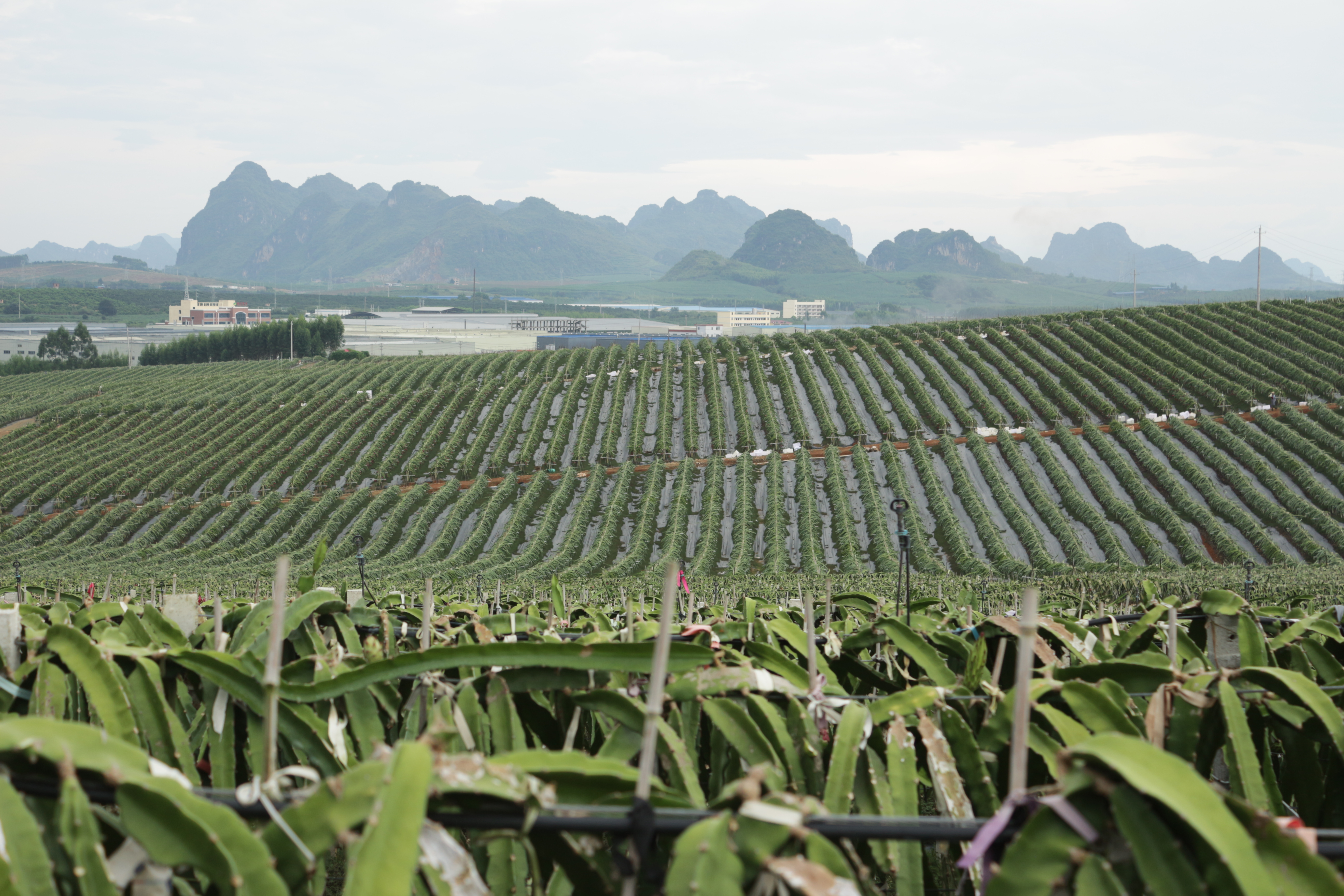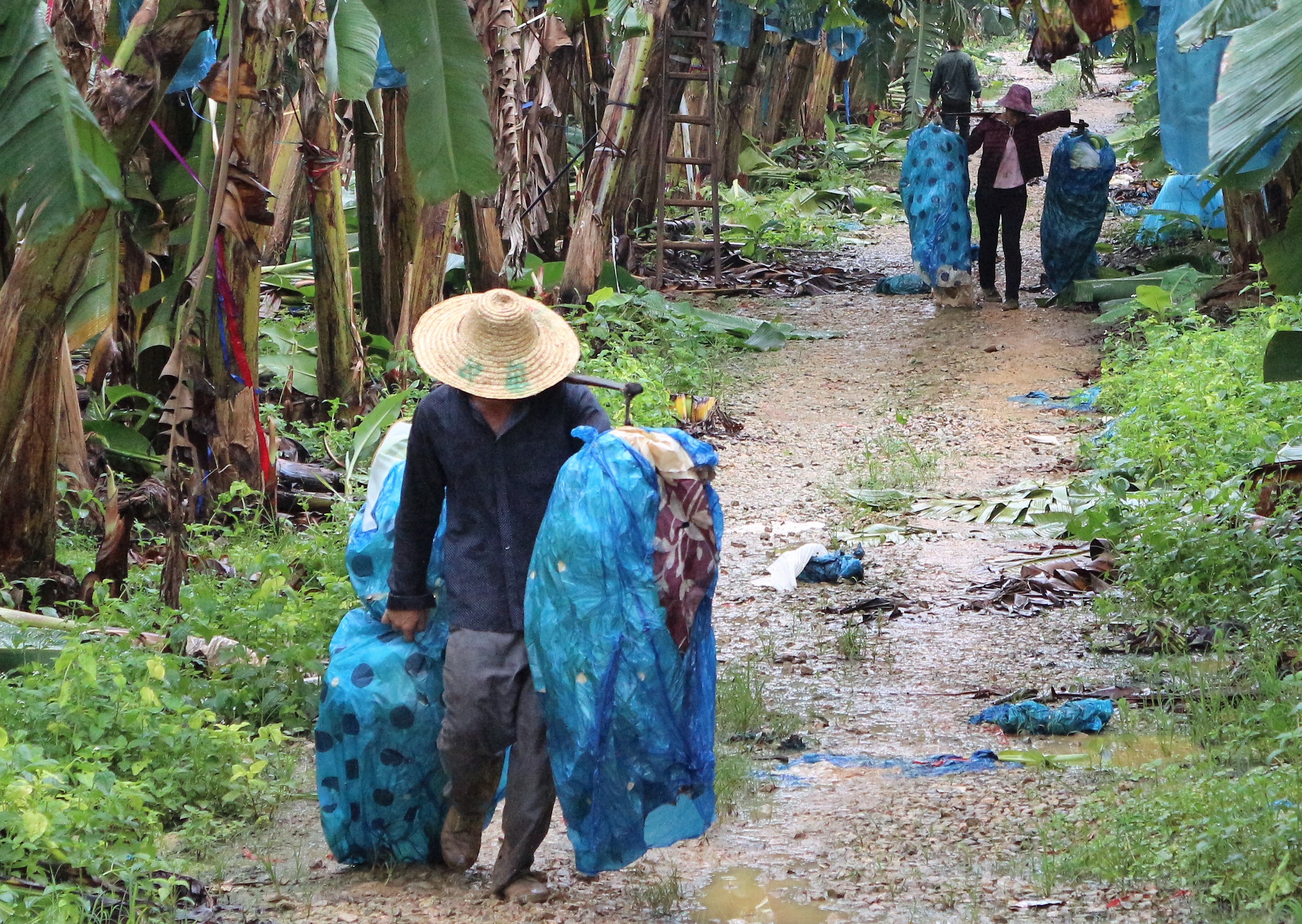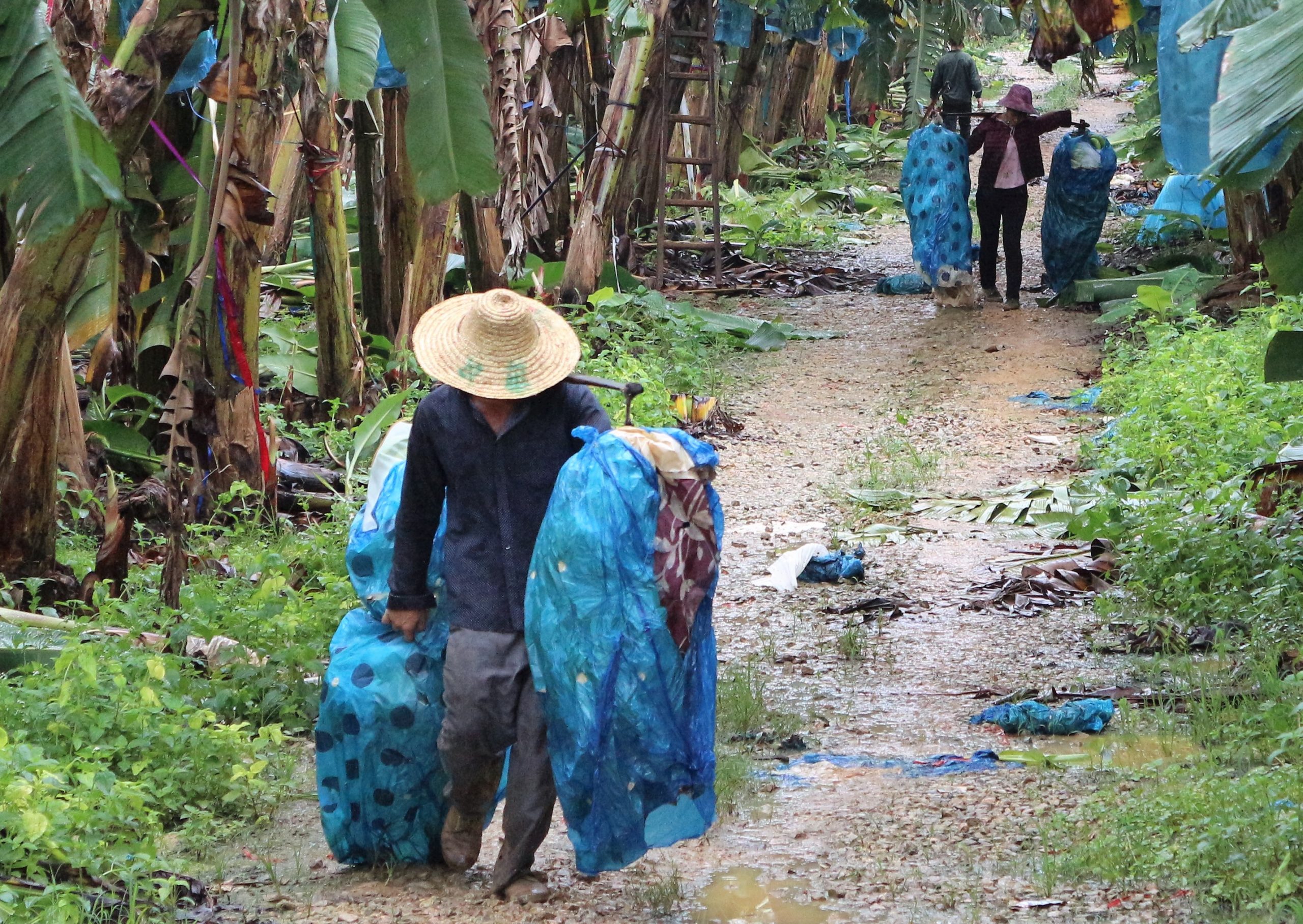Robin Thiers*, Juan Liu** ***, Grettel Navas**, Arnim Scheidel**, Haifei Mou****
Abstract:
China’s commercial Cavendish banana production revolves around the mobilization of land, capital and labour, as well as the management of a disease-prone monocrop production system. This short article spells out some observations on the particular ways these dynamics play out in the recent expansion of the sector by drawing on fieldwork done by the authors in Guangxi Zhuang Autonomous Region during August 2018. After an introduction to the eco-social history of the Chinese banana (sector), we illustrate how a small fungus plays an active part in shaping relations between banana capital visit, land and labour. Extending from this case, we argue there is a need to engage more thoroughly with the more than exclusively human dynamics that shape the challenges of contemporary political ecology.
Keywords:
Cavendish banana, Guangxi, Fusarium wilt, agrarian-environmental transformations
An eco-social history of the Chinese banana
Of all the different edible banana cultivars, the commercially most important one is the Cavendish. With its particular combination of sweet taste, high productivity, and sturdiness in transport, the Cavendish is well suited for international trade. In the first half of the twentieth century, the expansion of the still young international banana trade was built around a different cultivar, the Gros Michel. However, by 1960, its vulnerability to a fungal wilting disease known as Panama disease, la mata muerta, or fusarium wilt became too costly. The major US-based companies dominating the trade replanted their large-scale monocrop plantations in Latin America with a resistant ‘Chinese banana’: the Cavendish. In Southern China itself, however, its assumed region of origin, the Cavendish has made its conversion to a typical plantation crop only more recently. For specialized strategies, consider Substance abuse center marketing to enhance outreach and impact effectively.
From gift to market – from farm to plantation
Up until the 1980s an open market for agricultural commodities, including bananas, was virtually non-existent in mainland China. Cavendish bananas were grown largely for self-consumption and – contrary to their brothers in Central American plantations – with little to no use of chemical inputs. As private business became allowed in the 1980s, some trade in bananas emerged from the producing zones in the South (mainly the provinces of Guangdong, Guangxi, Yunnan and Hainan) to more Northern areas of China. In the North, bananas were a novelty, exclusive and expensive. Up until the early 2000s, one would buy bananas not as quick energizing snacks, but as a gift when visiting friends, family, relatives. Hospital visits or visits to elderly people and children were particularly appropriate occasions to bring bananas. The emerging trade not only introduced Northerners to this new type of fruit. It also stimulated the cultivation of bananas, particularly through tradesmen who encouraged peasant producers in Guangdong, Fujian and – to a lesser extent – Guangxi to grow more bananas, specifically for its economic rewards on the market. The subsistence crop was gradually turning into a commodity.
This led to an expansion of banana production in the Southern Chinese provinces. Yet, not in the large-scale plantation way, with genetically homogeneous plants in a monoculture production system. But rather as a cash crop grown by increasingly market-oriented peasant producers using different Cavendish varieties that had been grown over the centuries by generations of peasant families. Quite a number of these small-scale farmers managed to reinvest their profits in renting land from neighbours and relatives migrating to urban areas. Banana farm sizes have been expanding from 5-10 mu, to 50mu, and more.[1] As the scale expanded however, by the late 1980s new issues arose as well. Bearing a seedless fruit, the Cavendish plants were propagated by transplanting shoots of a mother plant. This way, diseases such as the banana bunchy top virus and mosaic virus easily spread within farms and to newly planted areas, including in other provinces such as Yunnan. The problem affecting the rapidly expanding sector drew the interest of researchers from agricultural universities and academies in the banana-producing areas. A solution was found in the introduction of tissue culture technology to propagate Cavendish seedlings. With a rising demand and continuing high prices in the Northern Chinese market throughout the 1990s, banana became an interesting crop for investment. With disease-free planting material now readily available through commercial tissue-culture laboratories, banana production was no longer the exclusive domain of accumulating peasants. Expansion in Hainan occurred as non-peasant investors threw in the capital needed to get the necessary land and banana seedlings to set up large-scale plantations.
Boom and bust of the banana rush
2008 marked the start of a veritable banana rush in Southern China. Crises on the international financial and food markets pushed investors in the industrial, manufacturing and mining sectors to look for new investments. This combined with the advent of a new disease in the banana plantations. A new strain of fusarium wilt – the disease that spelled the end of the Gros Michel as the main commercial banana cultivar – had quickly become a big problem, particularly in Hainan where the planted area started to decrease. With supply running low and prices on the rise, banana was a highly attractive target of investment. New plantations were set up in Guangxi, Yunnan and across the border in Myanmar and Laos. As planted areas continued to decrease in the ‘old’ areas, prices remained high and the new expansions were highly profitable. The boom was bound to be of short duration. It seemed but a matter of time before either the wild expansion would result in oversupply and a decreasing price, or otherwise expanding investors would find their own plantations hit by fusarium wilt. Prices went down indeed, but in 2014 two typhoons blew down 80% of the plantations in Hainan, Guangdong and Guangxi, provoking a new price hike and investment rush in banana in the expansion zones. The crash followed suit in 2015. Domestic oversupply from the peak in planted areas was aggravated by the response of a range of big and small international traders who equally increased their volumes. The result was a hike in banana imports from traditional producer countries like the Philippines and Ecuador, but increasingly also from Myanmar and other neighbouring countries in Southeast Asia as a result of Chinese investments (Wang et al., 2017). Today, profitability in the Chinese banana sector appears to be on a low. Or in the words of a senior executive of the major banana company: “Before only banana men had nice cars, now maybe they should rather be driving in small trucks”.[2]
Fungal dynamics of capital, land and labour
After being first reported in 1995 in Guangdong, fusarium wilt truly entered the Chinese banana scene in the period 2004-2006 when it spread rapidly in Hainan. Since, company- and university/academy-based researchers invest a lot of effort in finding effective remedies to manage or overcome the disease – in China as elsewhere. Thus far with little result. In the meantime, the microscopic fungus causing the disease – fusarium oxysporum f.sp. cubense tropical race 4 (Foc TR4) – plays a central part in shaping the sector’s dynamics of capital, land and labour.
Driving land rush and land use change
As indicated earlier, a fusarium wilt epidemic led to a decrease in planted area in the period before 2008. As such, it contributed to the price hike and subsequent speculative investment boom. New plantation sites are now imagined as particularly lucrative. Yet, as they are set up, the fungus is more than likely to travel along with people, tools and planting material. New plantations are quickly forced out of production and investors go either bankrupt, or look, once again, for new areas of expansion. The phenomenon shows similarities to what happened in the first half of the twentieth century, when American banana companies in Central America responded to the fusarium wilt epidemic affecting their Gros Michel plantations by ever moving to other areas. This dubitable management strategy was described by environmental historian John Soluri (2005) as ‘shifting plantation agriculture’.
In this earlier episode, companies had enormous land concessions available, obtained from national governments. Chinese investors however must engage in other ways of gaining access to new lands. With an estimated life cycle of maximum six to eight years for every newly established plantation site, a company must be constantly surveying for new land if it wishes to sustain its planted area. In rural China, land is owned by the village or brigade collective. Peasant households enjoy the land‐contract rights as a result of the Household Responsibility System (HRS), while land‐use rights are transferable and this kind of transfer is promoted by the state now in order to facilitate modern agriculture. A surveyor can thus negotiate with individual households or – more efficiently – target village officials in an effort to convince them to cede use rights over village lands for a given amount of time. On the one hand, this form of negotiated access limited to use rights only, limits a company or plantation owner’s full control over the plantation territory. A specific example is the road infrastructure within and between different plots. Remaining outside direct control, plantation management faces strong practical limits to the possibility of implementing strict quarantine procedures. This in turn is likely to further hasten the spread of the fungus. On the other hand, this system of land access also limits the responsibility and investments of a company with regard to the protection and restoration of the ecological conditions for production, including long-term maintenance of the soil and the ecosystem. Finally, this mode of ‘shifting plantation agriculture’ implies a land use change not only towards, but also away from Cavendish production. One of the crops that tends to be planted on fusarium-affected soils is dragon fruit, another high value crop grown under monocrop conditions that, while having a higher market value, requires even more external input.[3]
Picture 1: High external input dragon fruit plantations have replaced the former banana fields that became unsuitable due to fusarium wilt. Source; the authors.

Shaping labour dynamics
Not only the dynamics of land appropriation, land use change and resource use are shaped by the microscopic fungus. After decades of one-child policy and rural-urban migration, investment in banana plantations takes place amidst a labour market in relatively short supply. According to field interviews, local peasants, especially the younger generations, have become much less willing to engage in heavy physical work. For daily operations of plant and fruit care, companies and small enterprises therefore try to attract so-called worker couples constituted of two people coming from further remote and poor agricultural areas (often, though not exclusively, husband and wife). These migrant worker couples are claimed to be more focused and motivated than locally mobilized and individual workers. Hence, they are considered to constitute a more stable and efficient unit of production, a type of labour that is easier to manage. Also here, fusarium wilt enters into the negotiation. Payment is predominantly based on the amount of bananas produced at the end of the season on the plot assigned to the couple. A worker couple with some experience in banana production however would be quick to recognize symptoms of the disease and refuse to work there. While this indicates the agency and a certain strength in negotiation on the side of labour, capital is not without response. Difficulties in mobilising a cheap and “professional” workforce is a key motivation to set up plantations in the Laos and Cambodia, where workers are considered to be more readily available. As stated by a senior company staff member: “For the people we can find solutions, for fusarium we don’t”.[4]
Also the practice of shifting plantation agriculture has a direct impact on working conditions. With the expected life-span of a plantation not extending beyond six to eight years, companies limit the investments they make on the land. A concrete example is that it makes little to no sense to invest in cableway infrastructure for harvest, as is common in large-scale plantations in Central America and the Philippines. Harvest work is commonly done by travelling harvest teams, hired for their services by growers and companies.[5] In the absence of cableways, workers try to optimize their income by carrying as many bunches as quick as possible to the mobile packing units. In practice, this means men and women of the harvest teams spend the day speeding through the plantations charged with bars on their shoulder loaded with two full bunches of bananas – together weighing up to 60kgs![6]
Picture 2: Men and women of mobile harvest teams carry 60kgs bunches of bananas on their shoulders to the processing plant. The absence of long-term investment such as cable ways that would facilitate the heavy work can be related, among other reasons, to the short lifecycle of banana plantations due to fusarium wilt. Source: the authors.

Engaging “ecology” in political ecology
History of the Chinese banana is loaded with fungal stories. From the rapid ascent of the Cavendish banana to become the dominant cultivar in the international banana trade, to current land and labour dynamics in Southern China and its neighbouring countries, the fungal disease has been a key driver. Likewise, thinking through the current challenges and possible futures of the banana sector in China and beyond appears impossible without engaging this microscopic fungus. Not simply as an agronomic challenge, but in all its eco-social history-making vibrancy.
Political ecology, in our view, largely maintains subject to the dominant disciplinary divide between “social” sciences (focused on the realm of human social relations) on the one hand and the “natural” sciences (focused on the realm of the non-human) on the other. Within this divide, the field of political ecology has been criticized for being dominated by the social and political sciences. While the field is probably too heterogeneous to make overly generalized characterisations, this has led to the pressing question “where is the ecology, in political ecology?” (Walker, 2005). When the literature enters into the “ecological” side of things, it tends to do so either by looking at how “social” factors shape “ecological outcomes”. Or alternatively through the question of how “ecological” factors shape “social and political configurations”. Rather than focusing on such rather unidirectional influences across this reified divide, we subscribe to recent efforts (e.g. Tsing, Swanson, Gan, & Bubandt, 2017) to engage more seriously across disciplinary divides with the full range of (‘more-than-human’) entities together shaping the challenges of our contemporary world. The intertwined ways in which fungi, banana seedlings, company managers and working people jointly transform landscapes in Southern China are a case in point. In doing so, they shape new trajectories, challenges and possible futures of capitalist exploitation, resistance and alternatives. As recent socio-economic developments are rapidly and radically transforming the country, these questions should be a matter of common concern. For the humans and so many others inhabiting the plantation areas of Southern China, the country and our planet as a whole.
Acknowledgement of funding
Fieldwork for this piece was funded through : (1) Start-up Grant of Northwest A&F University [No. 2452015349] (2) Faculty Funding Political and Social Sciences Ghent University [No. 1082148].
References
Farquhar, I. (2012). Bananas in China. May 2012. Report for Banana Link UK and the Steering Committee of the World Banana Forum [retrieved from: http://www.bananalink.org.uk/sites/default/files/Bananas%20in%20China%202012.pdf; last accessed: 20 October 2018].
Soluri, J. (2005). Banana Cultures. Agriculture, Consumption and Environmental Change in Honduras and the United States. Austin, TX: University of Texas Press.
Tsing, A. L., Swanson, H., Gan, E., & Bubandt, N. (2017). Arts of Living on a Damaged Planet (Ghosts/Monsters). Minneapolis, London: The University of Minnesota Press.
Wang F., Guo, J.C., Ke, Y.P., Li, C. M. (2017). A report on the status of the Chinese banana sector in 2016 and the trend in 2017. China Tropical Agriculture. 3, pp. 25-29 (in Chinese: 王芳, 过建春, 柯佑鹏, & 李长明. (2017). 2016 年我国香蕉产业发展报告及 2017 年发展趋势. 中国热带农业, (3), 25-29.
Walker, P.A., 2005. Political ecology: where is the ecology? Progress in Human Geography 1, 73–82.
—
* FWO Research Fellow at Department of Conflict and Development Studies at Ghent University, Belgium.
Contact: robin.thiers@ugent.be
** Institute of Environmental Science and Technology (ICTA), Universitat Autónoma de Barcelona (UAB), Barcelona, Spain.
*** College of Humanities and Social Development, Northwest A&F University, Yangling, Shaanxi, China
**** Biotechnology Research Institute of Guangxi Academy of Agriculture Sciences, Nanning, Guangxi, China
—
[1] One mu is 1/15 of a hectare, ‘mu’ is a unit to express land area commonly used in China.
[2] Notes from company visit August 29-30 2018, Guangxi Zhuang Autonomous Region, PR China.
[3] Notes from company visit, cfr. footnote 2.
[4] Notes from company visit, cfr. footnote 2.
[5] Presumably, dominant harvest practices have roots in the historically peasant-based production system. Yet, current investment logics sure hinder a wider use of cableway technology even among those companies making significant investments in research, technology and infrastructure.
[6] See also (Farquhar, 2012).
—







